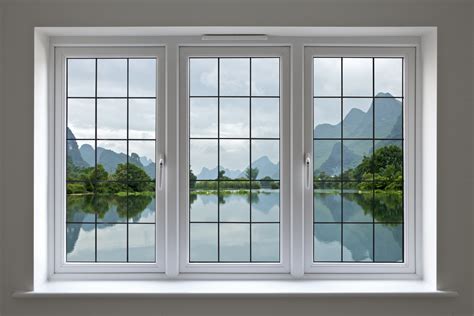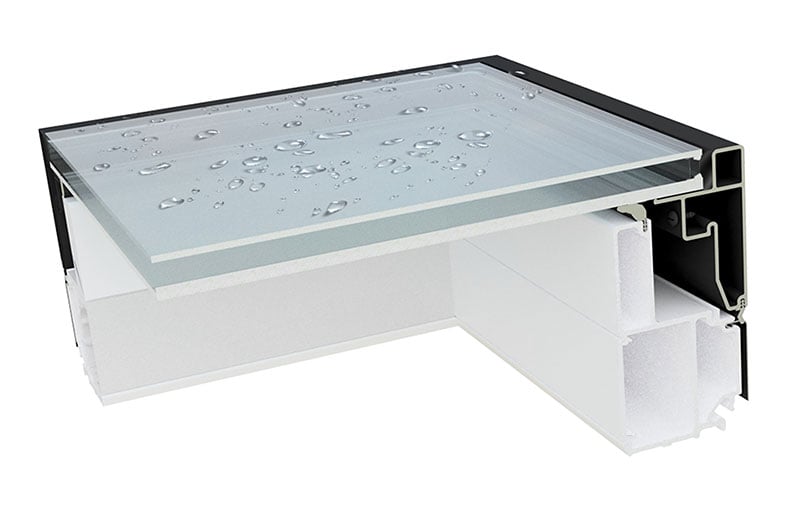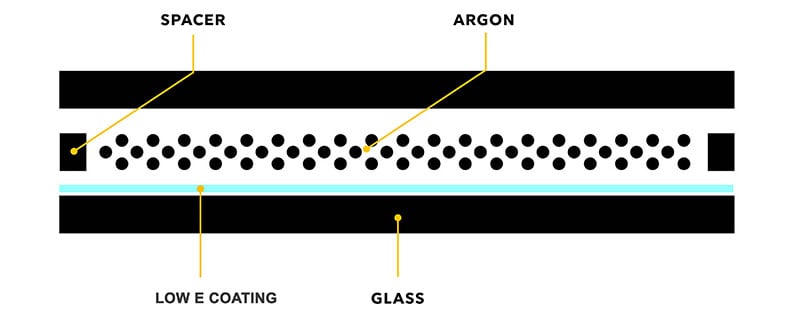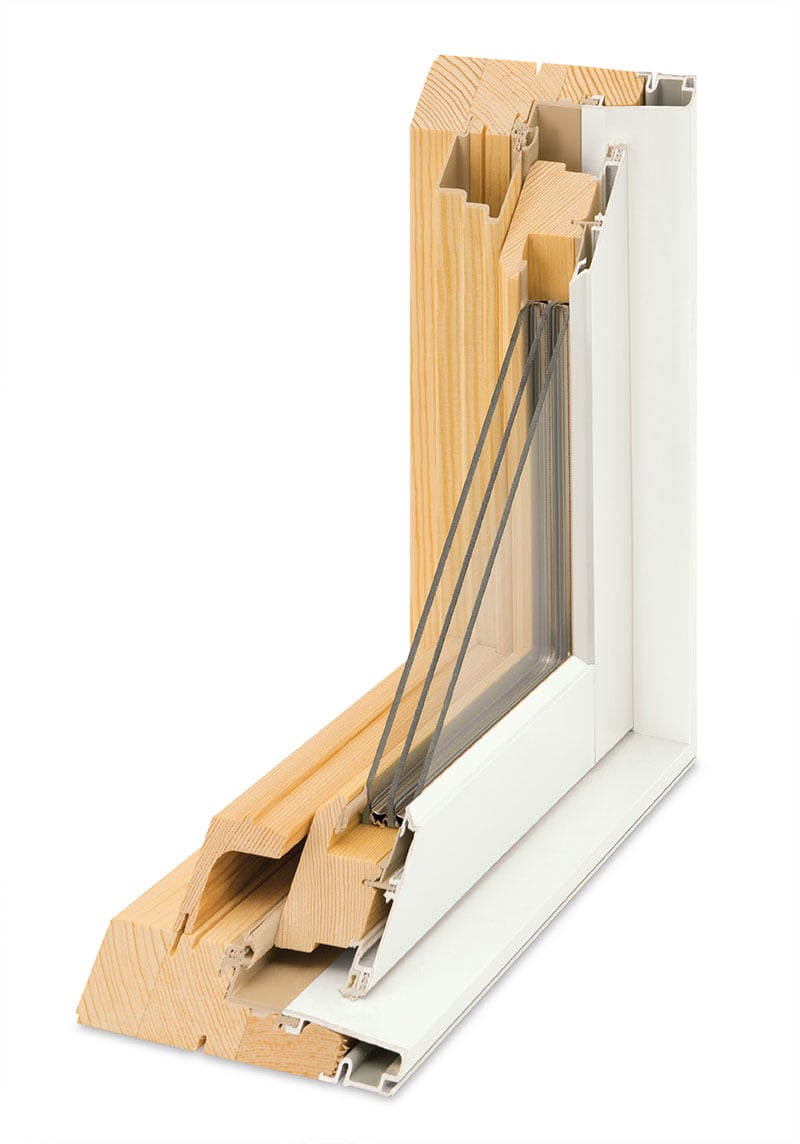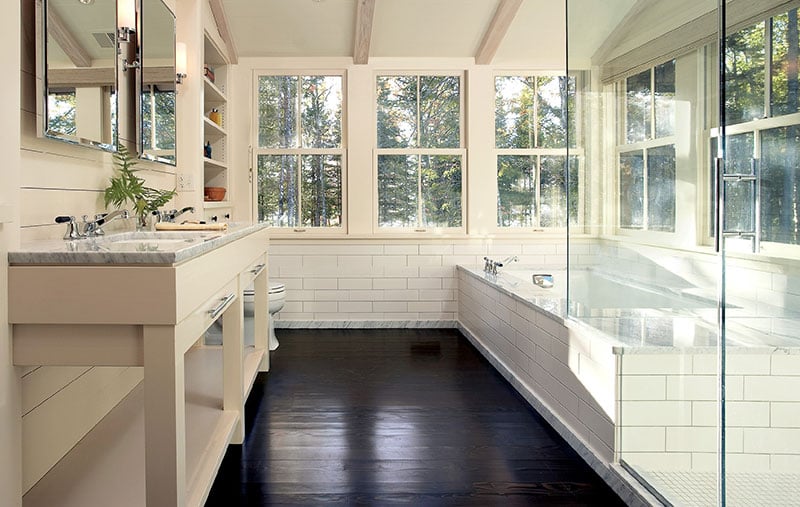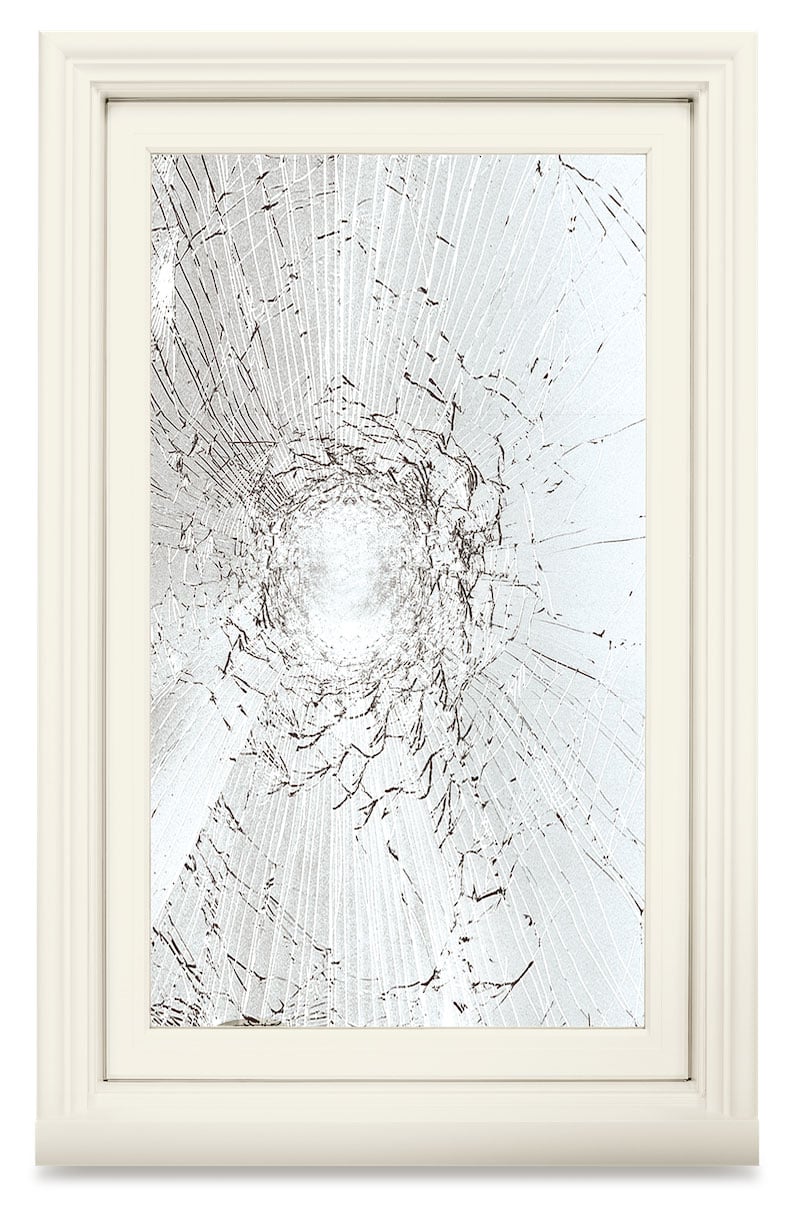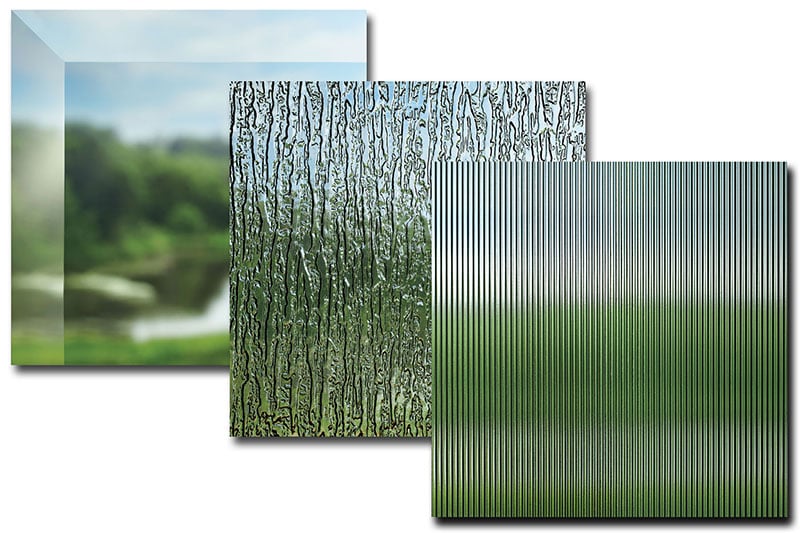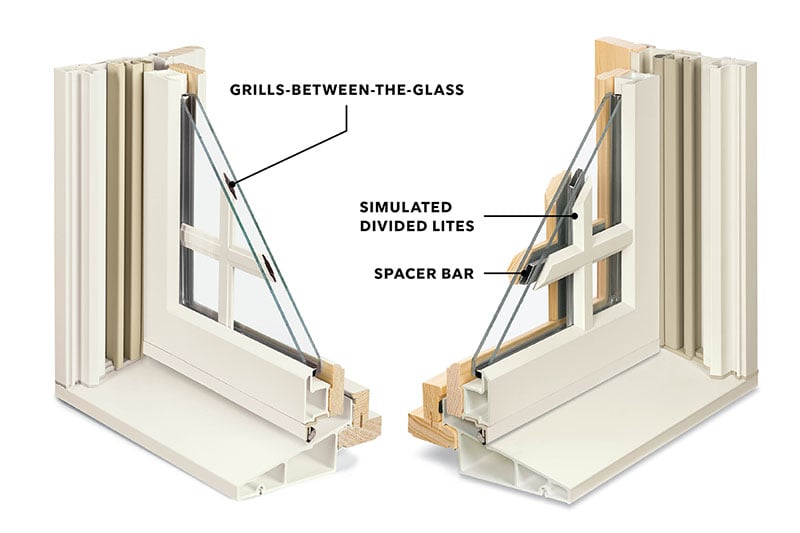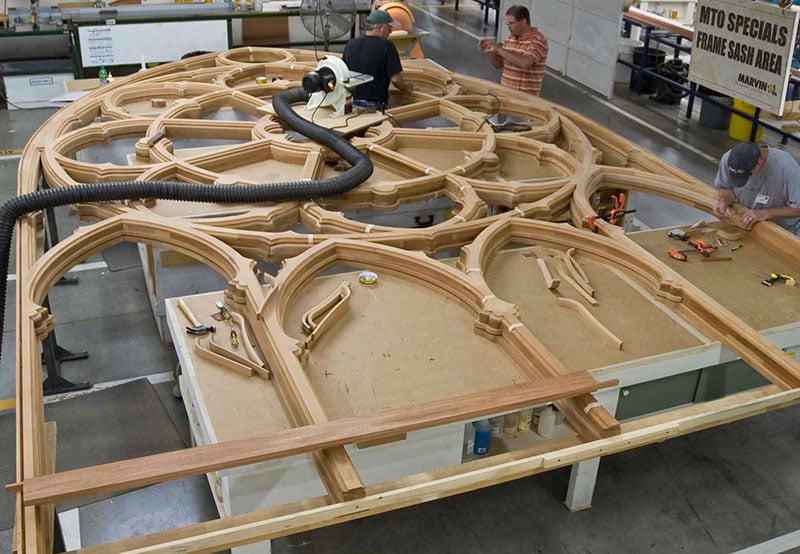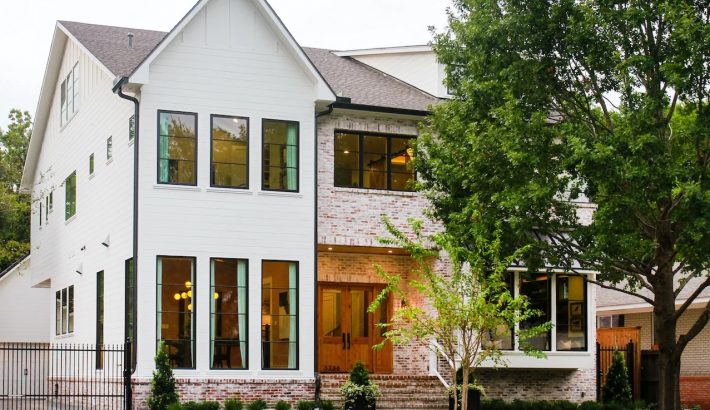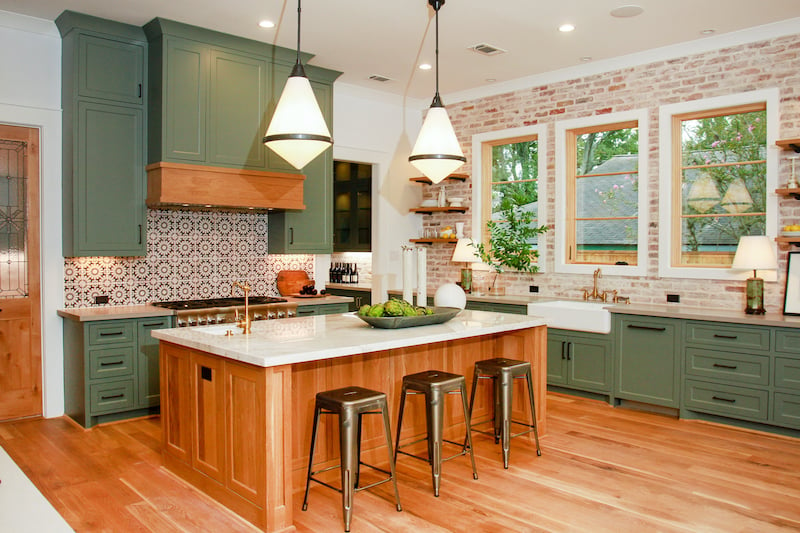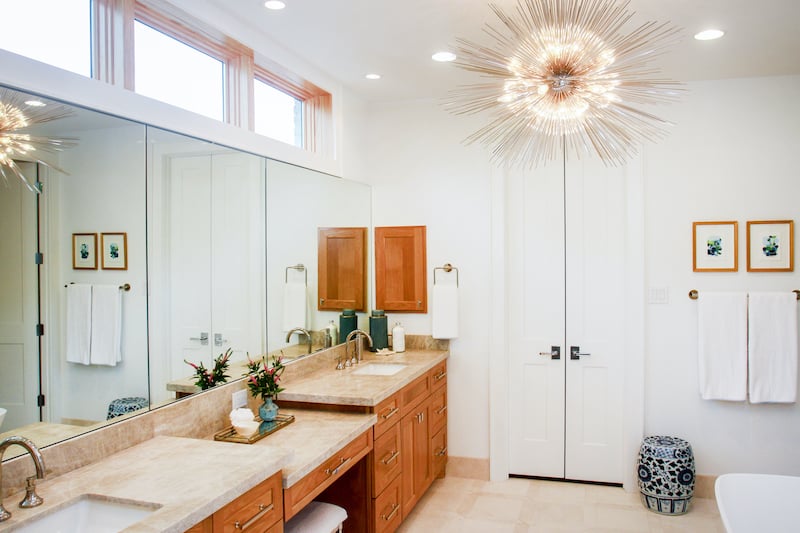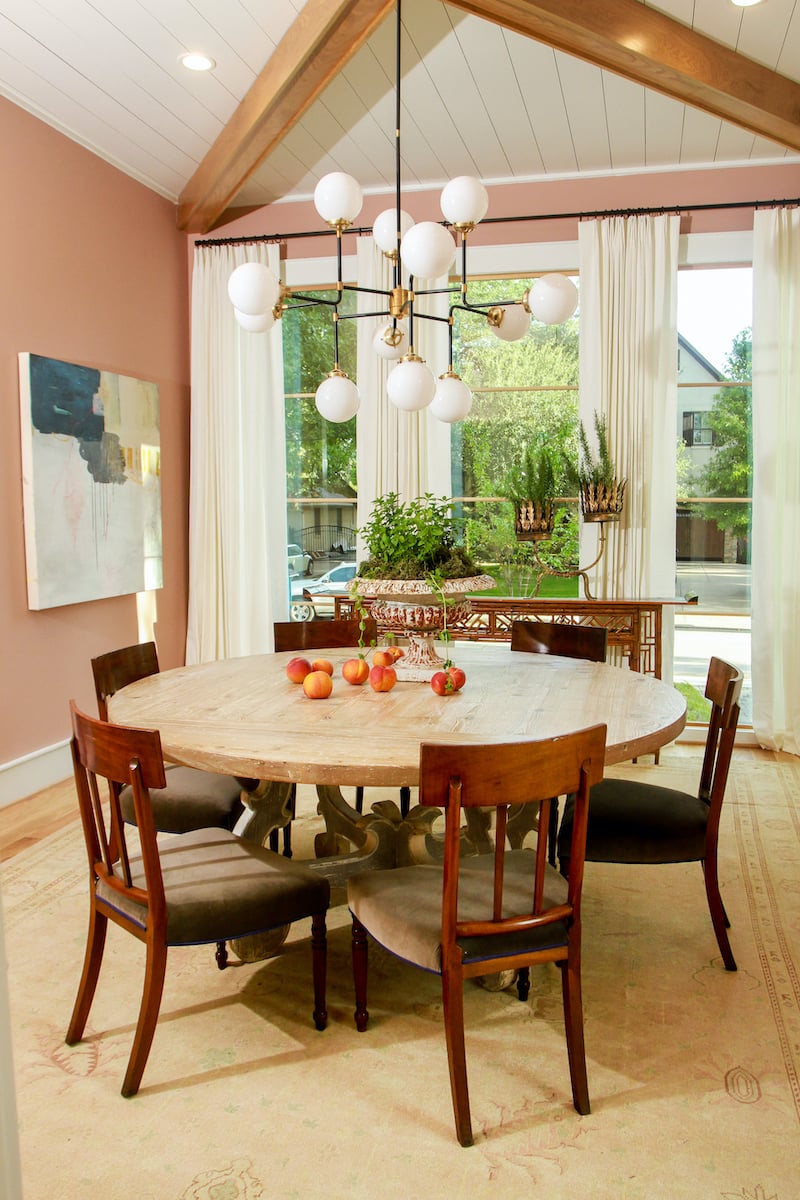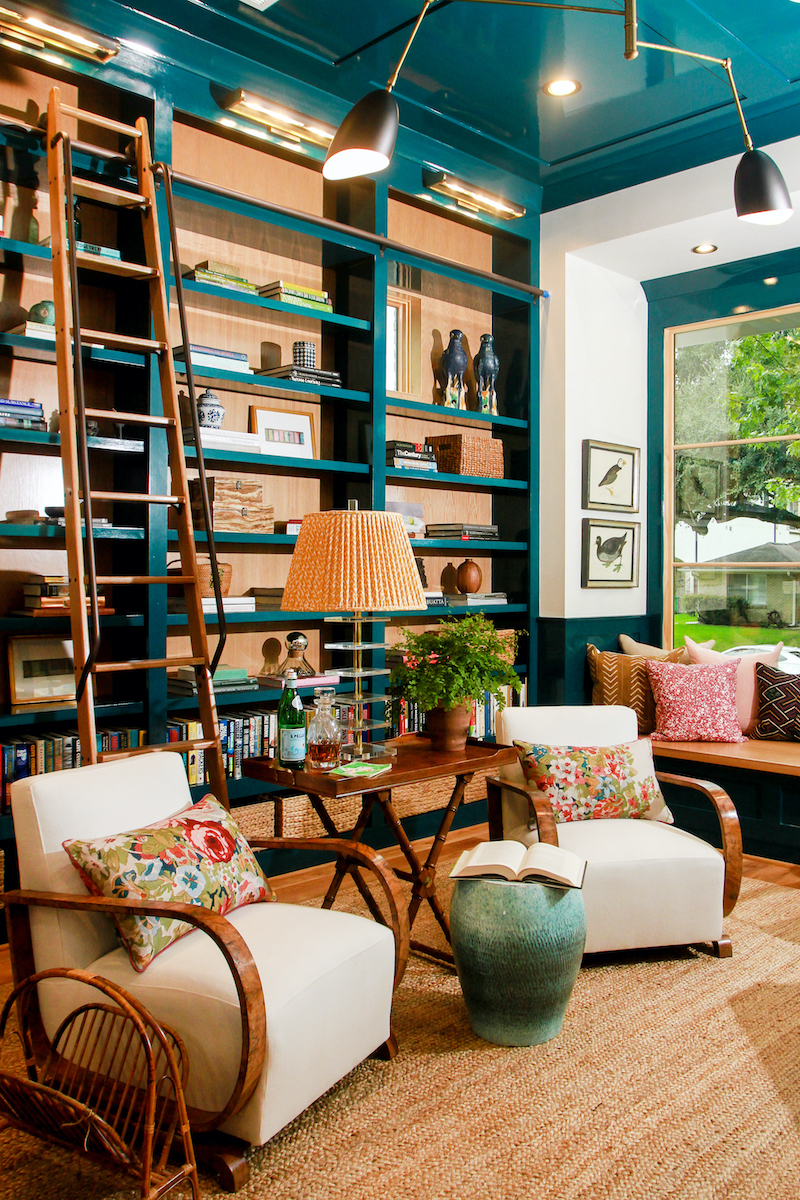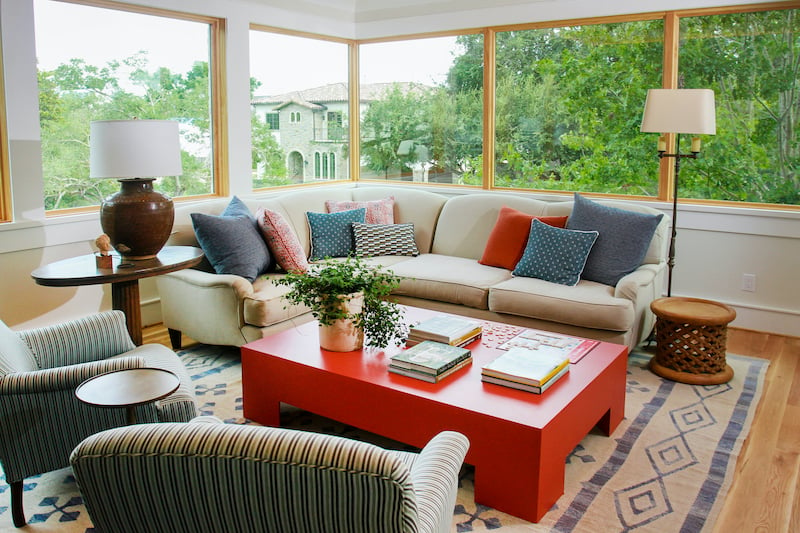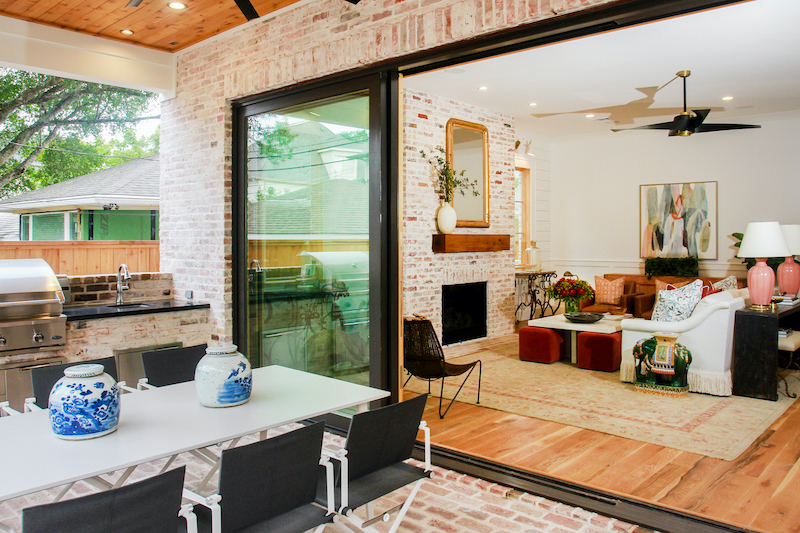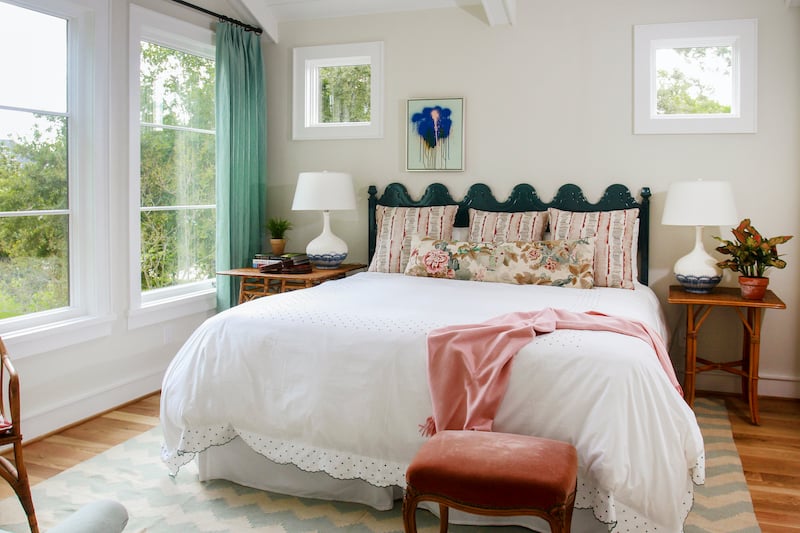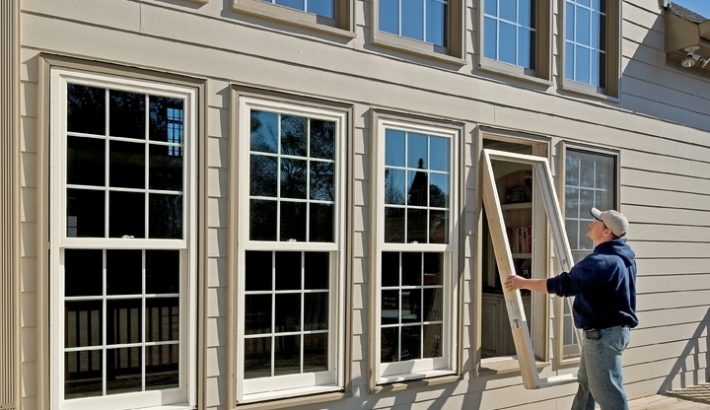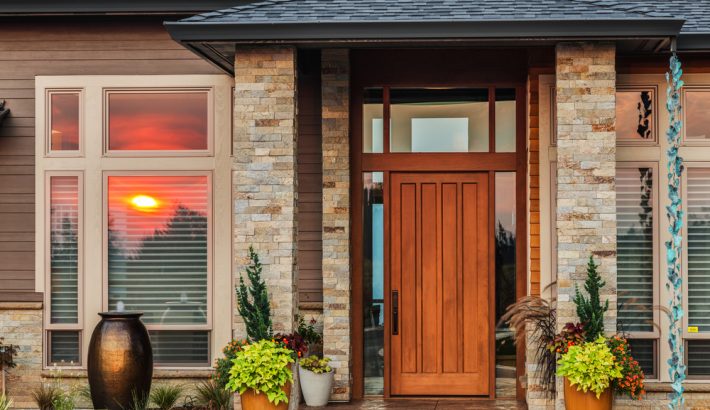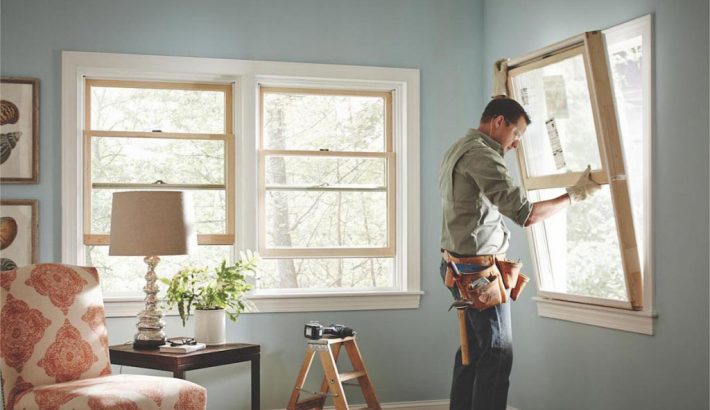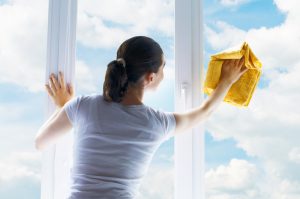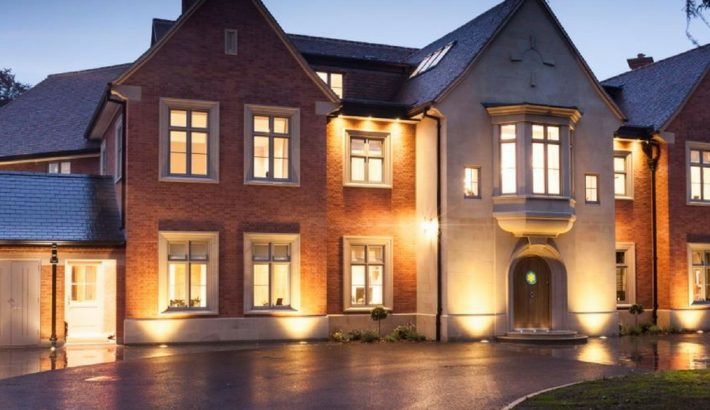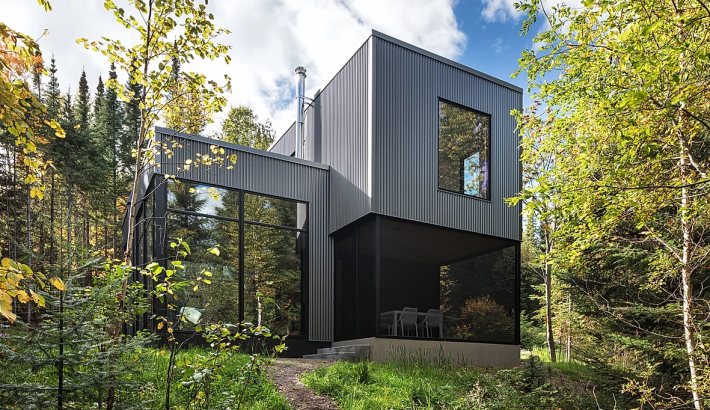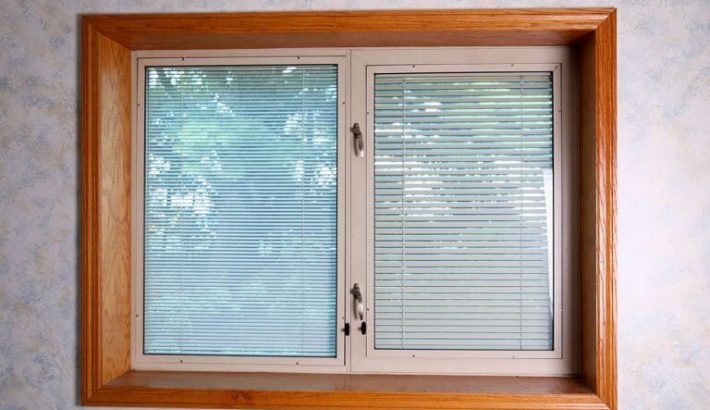Quality Window & Door Installs New Windows in Historic Bank
We installed new Marvin windows last month in the former First National Bank of Angola Building. The windows turned out beautiful and the Angola Historic Preservation was pleased with the outcome.
ANGOLA — A second set of replacement windows to be installed at the former First National Bank of Angola building on the Public Square started going in on Monday afternoon and appear to be complete, minus some trim.
“The HPC is very pleased with how this situation turned out. The company that owns the bank building went from willfully ignoring the City of Angola’s laws regarding historic preservation to being quite cooperative, even making changes HPC didn’t ask for. It was a refreshing change of attitude,” said Lee Sauer, president of the Historic Preservation Commission.
Once completely renovated, the former bank building will be headquarters for two of Blake’s businesses, Our Country Home and EnTrust Capital Management. Interior work is expected to be completed next month, a company spokesman said.
A HOMEOWNER’S GUIDE TO UNDERSTANDING GLASS PERFORMANCE AND TYPES
You don’t need to completely understand the technology, but you should know that you have options.
When purchasing a window, most homeowners think about the type of operation they want—casement, double hung, glider, etc. They also consider the color and maybe even how a window’s aesthetics complement the architectural style of their home. But often, very little consideration is given to the glass itself. Many people don’t even know they have an option of choosing one type of glass over another. Here is a helpful guide about the performance of glass, glass types, and the various glass options. Whether building a new home, remodeling, or considering replacement windows, this article will give you a better understanding about which window glass will be best for your home.
Two Panes Are Better Than One
While glass objects were being made as early as 2500 BC, glass windows did not become a standard feature in the average home until the 17th century. For the next 300 years, windows were constructed with a single pane of glass, which worked fine for letting in sunlight, providing views, and preventing wind and rain from entering a home, but one pane was not effective at keeping homes warm in the winter or cool in the summer. In the 1950s, residential glass manufacturers started combining two panes of glass separated by a small air space. The motionless air between the panes acted as an insulator and reduced the buildup of condensation in the winter. This new technique decreased the dependence on storm windows but was just the beginning of the improvements to come.
Low E Coatings Block Radiation
Radiation from the sun, in the form of infrared light, can shine through a window and heat up the objects inside a room, which is not what you want on a hot summer day. Also, warm objects themselves can emit heat radiation, which means a warm room can lose heat by radiating it right through the window glass to the outdoors, and that’s less than desirable on a cold winter night. Glass alone will not reduce the effects of radiant heat transfer, but low emissivity (Low E) coatings can.
Low E coatings are microscopically thin metal coatings added to the surface of window glass. They are designed to reflect radiant heat, which reduces heat gain in the summer and heat loss in the winter. Low E coatings can also block ultraviolet light (UV) produced by the sun. UV radiation can cause flooring, furniture, and other indoor objects to fade and deteriorate. Ultraviolet light is also the form of radiation produced by the sun that causes damage to our skin.
A Low E coating is hundreds of times thinner than a human hair, so it’s nearly invisible and only noticeable as a slight tint. They are often made out of silver because of that metal’s ability to reflect radiation without significantly altering visibility. Adding additional layers and switching which surface they are applied to will change the performance of the glass. There are different proprietary names for these coatings, but one way to distinguish one type of Low E glass from another is by how many coatings have been applied. Low E glass has one coating, Low E2 has two, and Low E3 has three.
Insulating Glass With Gas
The first examples of dual pane glass were created by physically welding two panes together around the perimeter. While an improvement over single pane glass, the process only allowed the two panes to be separated by a very small space, less than 1/8 inch. Glass manufacturers eventually discovered that they could achieve greater insulating values by separating the two panes by about 1/2 inch and filling the space with argon, an inert gas found in the air we breathe. This type of assembly is referred to as an insulating glass unit (IGU). Krypton is an even more effective insulating gas than argon and will achieve the same insulating values in a space smaller than 1/2 inch, but krypton is much more expensive to create, which is why argon remains the standard in insulating glass. While insulating glass helps thermal performance, indoor comfort levels are still mostly controlled by Low E coatings.
How Glass is Rated
Here are the three primary ways window and door glass is rated.
U-FACTORSimply put, U-factor measures how well a window keeps heat inside your home. It’s a measure of total heat flow through a window from room air to outside air. Lower numbers indicate greater insulating capabilities. It’s a particularly important measurement for climates with colder winters.
SOLAR-HEAT GAINIf U-factor denotes how much heat leaves your home, the Solar Heat Gain Coefficient (SHGC) measures how much radiant heat enters your home. All you really need to remember is: The lower the number, the less heat a window lets in.
Visible Transmittance
As you may have guessed, this measurement describes how clear the glass is. While Low E coatings are thin, each layer does reduce the visibility just a little. The higher the visible transmittance number, the clearer the glass.
| GENERAL GUIDELINE | ||
|---|---|---|
| ZONE | WINDOWS | |
| U-FACTOR | SHGC | |
| NORTHERN | ≤ 0.30 | *Any |
| NORTH CENTRAL | ≤ 0.32 | ≤ 0.40 |
| SOUTH CENTRAL | ≤ 0.35 | ≤ 0.30 |
| SOUTHERN | ≤ 0.60 | ≤ 0.27 |
Which Window Glass is Best for Your Area?
If you live in a colder climate the less heat you want escaping your home and the more radiant heat from the sun you want entering your home in the winter months, which means a lower U-Factor and higher SHGC.
If you live in a warmer climate, heat escaping your home is not as important as preventing the radiant heat from the sun from entering, which means a higher U-Factor and lower SHGC.
There are additional factors when considering Low E coatings. If you want to protect grandma’s family heirloom or a valuable art collection, you may want to add specific coatings that will reduce the harmful effects of UV radiation, even if you live in a cold climate. In far northern climates the sun will not shine directly through windows located on the north side of the building, so it may be unnecessary to install windows with a high SHGC to take advantage of the warm sun rays. Large shade trees can reduce the need for windows with a low SHGC. If perfectly clear glass is important to you, remember that the more coatings you apply to a window, the more tint it will have.
This is a lot of information to digest, but here’s the bottom line when it comes to glass performance: when building a new home or replacing windows in your existing home, make sure to have a conversation with the installation contractor or window dealer. Let them know which glass characteristics are most important to you.
*In northern climates it’s sort of a “pick your poison” when it comes to SHGC. If you choose a window with a low SHGC, you could benefit from the sun’s heat in the winter, but you also may have to manage the heat from the summer sun with shades, large overhangs, shade trees, etc.
Is Triple Pane Glass the Best Solution?
Windows with triple pane glass are more expensive. If you live anywhere but the coldest climates, the extra cost is unlikely to pay off in energy bill savings within the lifespan of the windows, especially if the rest of your home is poorly insulated. It’s not just the extra pane of glass that increases the cost. Adding a third pane increases the thickness and weight of an IGU, so window sashes, frames, and hardware need to be reconfigured to accommodate that extra size and weight.
All that said, an additional pane of glass creates an additional space which can be filled with argon and an additional surface in which to install another Low E coating. More insulation can provide an extra layer of comfort, especially in cold climates. Another advantage is that condensation is less likely to form on the inside of the glass when the temperatures dip far below freezing. Many people who live in a loud city or near an airport choose that extra layer of glass because windows with three panes will reduce more outdoor sounds that reach the inside of a home.
Tempered Glass is Tough
Tempered glass is considered “safety glass.” It’s manufactured in such a way that makes it up to four times stronger than standard glass. Also, if tempered glass does break, it shatters into tiny pieces which are much less likely to cause an injury than the large, sharp shards of falling glass that are generated when standard glass is broken.
Building codes often require a window be made with safety glass if it’s installed in a location where there is an increased risk that a resident could fall and collide with a window. Examples include areas where a window is installed close to the floor, in bathrooms near a tub or shower, and stairways. All glass doors and extremely large windows also require safety glass like tempered glass.
Laminated Glass Holds Together
If you live on a golf course and someone drives a ball into your bedroom window, chances are, the glass will break and fall into the room in large dangerous shards. If your bedroom window is fitted with tempered glass, the odds are greater that it will withstand the impact, but there’s still a chance it will break and spray small fragments of glass into the room. If that same ball hits a pane of laminated glass, the glass could still break, but if it does, the sharp fragments will stay intact inside the window sash.
Like tempered glass, laminated glass is considered “safety glass.” It’s constructed by sandwiching a thin, near-invisible sheet of plastic between two panes of glass. When a laminated glass pane is broken, the plastic holds all of the pieces together. In addition to preventing airborne glass, laminated glass is strong and cannot be cut with a standard glass cutter, so it offers an additional layer of security against forced entries. Another benefit of laminated glass is that it’s better at dampening loud sounds than non-laminated glass.
Impact-Resistant Glass Can Protect People and Property
Homes in many coastal regions need extra protection from high winds and flying debris generated from tropical storms and hurricanes. Impact-resistant glass, sometimes referred to as impact glass or hurricane glass, is stronger than standard safety glass. Impact-resistant glass is laminated but made with a thicker plastic inner layer and may contain thicker panes as well. Some impact-resisting glass units are assembled with both laminated and tempered glass.
Impact-resistant glass is tested by hurdling 2x4s at it at speeds near 35 mph and small steel balls at near 90 mph. It holds together amazingly well, especially when installed in a thick aluminum frame. And when the storm winds do blow, it’s important to have a window you can rely on, because if the window glass, sash, or frame should fail, a house in a hurricane can become pressurized, which could cause the walls to be pushed out and the entire roof to be blown off.
Decorative Glass
From the early days of glass making, it took a few thousand years to figure out how to make glass perfectly clear. Today, clear glass is not always what’s called for. Tinted, frosted, and obscured glass can be used on windows in bathrooms, in sidelights attached to a front door, or in any area in a home where both privacy and natural light are important. Textured glass can also add a touch of distinction on doors with glass panels.
Divided Lights
Up to the middle of the 19th century, large panes of glass were fragile and expensive to manufacture. In order to create large windows, muntin bars were used to join smaller individual panes. Today, expansive IGUs are stronger, less expensive to manufacture, and more energy efficient, so true muntin bars have largely been replaced with simulated divided lite (SDL) bars, which rest on the surface of the glass. Spacer bars can be added inside the glass between the SDL bars, which creates a more accurate replication of muntin bars. Grilles-between-the-glass (GBGs) are also available. As the name suggests, GBGs are decorative bars installed between the glass panes with no SDL bars on the surface. From the street, GBGs look like muntin bars, but because they live between the two layers of glass, the glass is easier to clean and maintain.
What About the Rest of the Window?
When it comes to performance, durability, and protection, glass is only one part of the equation. The type of material a window frame and sash is made out of matters, as does the craftsmanship that goes into building a window. Materials like fiberglass do not expand and contract or become distorted like some vinyl products. Window distortion can subject an IGU to uneven pressure, which can lead to a seal failure that allows the argon gas to escape. Without the argon, a window’s insulating properties are diminished. Broken seals can also cause condensation to form between the two panes, which may result in cloudy stains that can diminish a view.
A premier manufacturer of made-to-order wood, clad, fiberglass, and aluminum windows and doors, Marvin builds its principle of human-centered design into every product. With over 100 years of industry experience, Marvin has built a reputation for delivering the finest craftsmanship in windows and doors.
MODERN FARMHOUSE JOINS CONTRASTING STYLES FOR A UNIQUE, YET SEAMLESS, LOOK
Building a modern farmhouse is the perfect opportunity to incorporate a contemporary and uncluttered design in a rustic and nostalgic fashion. This beautiful home, located in Houston, TX, was built by Sarah Lavine-Kass and Benjamin Lavine, the sister-brother team behind Stone Acorn Builders. In this home build they combined design elements, selected mixed colors and finishes, incorporated new building products, and took advantage of natural light.
Modern Design Elements Blend with Warm Colors and Materials
Creating a comfy-chic aesthetic while still conveying a sense of history was a priority for Lavine-Kass.
“The clean trim lines, light fixtures, and hardware are the most contemporary elements in the home. Also, in the past we have always stained our Marvin windows, but in this home, we achieved a more minimal and modern look by applying a clear coat to the window sashes and frames and surrounding them with white trim. Mixing those modern elements with salvaged brick, salvaged wood, and other warm colors helped us balance the “new-old element.”
Hardware Diversity
Blending design elements to achieve a balance between modern, clean lines and more traditional styling is also evident in the selection of hardware colors and finishes.
“French brass and satin bronze are all the rage and we did use some of these colorways in the house, but we also used matte black, polished nickel, chrome, and white and black enamel,” Lavine-Kass says. “If the thread is carried throughout and transitioned at the right places you can get all of those finishes in. The trick is making it feel organic and not disjointed.”
Teamwork
The paint color variation is as pronounced as the other elements in this home, and Lavine-Kass gives all the credit to her team.
“The designers were the stars of the paint colors. Meg Lonergan’s dusty pink dining room choice looked sophisticated and transitioned well to the greens she used in the kitchen area and played well with Lindsey Herod’s peacock blue in the library across the hall.”
Harnessing the Light
There’s no better way to pull together the contrasts and highlight the complements between the various finishes and rich colors than with natural light. And taking advantage of the natural light was a priority to Kass-Lavine and her team from the very beginning stages of this project.
“We wanted to bring as much light in as possible, as well as some appreciation of outside—even though we are on an in-fill lot in town,” she says. “The eight-foot-tall Marvin window units in the dining room bring in gorgeous light and showcase the 11-foot architectural ceilings. We also used a Marvin corner window in the second-floor family room. The view of the treetops and the eastern sky through that window is one of the best in the house.”
Form, Function, and the “Wow” factor
Another advantage of the modern farmhouse design is the freedom to deviate from conventional building materials and include newer products that may feature a distinctive form or enhanced function.
“We chose James Hardie siding, but instead of using our go-to Artisan Lap Siding, we opted to use the new V-groove, which gave us great tailored lines for the home’s exterior. Also, to mitigate water run-off, we decided to use Belgard permeable pavers for the driveway, sidewalk, and walkways. Another new product for us was the Marvin multi-slide door that opens the family room to the outdoor summer kitchen. The multi-slide was a big hit during the open house—and so smooth to operate.”
Managing Costs
During a four-day period in 2017, Hurricane Harvey dropped a year’s worth of rain on the Houston area. Many neighborhoods were devastated.
“This home went up in a neighborhood hit hard by Harvey,” Kass-Lavine says. “It’s in a tenuous place with pricing as the area is recovering.”
It was important to keep costs down while building in a neighborhood that was just getting its feet under it again. Thoughtful selections of window and door products based on function and finishes were required. Stone Acorn installed Marvin Ultimate products in impactful spaces like the family rooms but chose Marvin Elevate windows throughout the rest of the house.
“The Marvin cladding options are great, and it’s very helpful that we can mix and match the product lines given that the colors work well together as well as the divided light patterns. We love Marvin Ultimate products, but the Elevate collection helped us achieve the look we wanted while providing some important savings given the uncertainty of this market.”
Update Your Windows & Doors for Energy Efficiency
Energy efficient windows are an important consideration for both new and existing homes. Heat gain and heat loss through windows are responsible for 25%–30% of residential heating and cooling energy use.
If you are selecting windows for new construction or to replace existing windows, it’s important to choose the most efficient windows you can afford that work best in your climate.
If your existing windows are in good condition, taking steps to reduce the energy loss through windows can make your home more comfortable and save you money on energy bills.
You have two broad options if you hope to reduce the amount of energy lost through your windows and improve the comfort of your home:
- Update your existing windows to improve efficiency
- Replace your windows.
Update Existing Windows to Improve Efficiency
If your windows are in good condition, taking steps to improve their efficiency may be the most cost-effective option to increase the comfort of your home and save money on energy costs. There are several things you can do to improve the efficiency of your existing windows:
- Check existing windows for air leaks
- Caulk and weatherstrip. Check out our do-it-yourself project to learn how to weatherstrip double-hung windows.
- Add window treatments and coverings. Learn more about your window treatment options.
- Add storm windows or panels
- Add solar control film
- Add exterior shading, such as awnings, exterior blinds, or overhangs.
With any efficiency improvements, take steps to ensure proper installation and check for air leaks again after making the improvement.
Replace Your Windows
If you decide to replace your windows, you will have to make several decisions about the type of windows you purchase and the type of replacement you will make.
You may have the option of replacing the windows in their existing frame; discuss this option with your window retailer and installer to find out if it will work for you.
You will also need to decide what features you want in your windows. You will need to decide on the following:
- Frame types
- Glazing type
- Gas fills and spacers
- Operation types
Visit the Window Types page for more information on all of these options.
Selection Process
In addition to choosing the window type, you also need to consider design, energy use and labeling, warranties, and proper installation.
First look for the ENERGY STAR label when buying new windows. Then review ratings on the energy performance label from the National Fenestration Rating Council (NFRC) to find the most efficient windows for your needs.
NFRC ratings are included on all ENERGY STAR certified windows and provide a reliable way to determine a window’s energy properties and compare products. Learn about energy performance ratings for windows to understand how to read the labels and energy-use information.
The Efficient Windows Collaborative offers a selection process for both replacement windows and windows for new construction:
For more specific recommendations, download the window selection fact sheets for your state.
Then use the window selection tools for replacement windows or new construction to compare options based on your climate and home design.
Window Selection Tips
- Look for the ENERGY STAR and NFRC labels.
- In colder climates, consider selecting gas-filled windows with low-e coatings to reduce heat loss. In warmer climates, select windows with coatings to reduce heat gain.
- Choose a low U-factor for better thermal resistance in colder climates; the U-factor is the rate at which a window conducts non-solar heat flow.
- Look for a low solar heat gain coefficient (SHGC). SHGC is a measure of solar radiation admitted through a window. Low SHGCs reduce heat gain in warm climates.
- Select windows with both low U-factors and low SHGCs to maximize energy savings in temperate climates with both cold and hot seasons.
- Look for whole-unit U-factors and SHGCs, rather than center-of-glass U-factors and SHGCs. Whole-unit numbers more accurately reflect the energy performance of the entire product.
Learn more about energy performance ratings for windows.
Installation
Even the most energy-efficient window must be properly installed to ensure energy efficiency and comfort. Have your windows installed by trained professionals according to manufacturer’s instructions; otherwise, your warranty may be void.
Window installation varies depending on the type of window, the construction of the house (wood, masonry, etc.), the exterior cladding (wood siding, stucco, brick, etc.), and the type (if any) of weather-restrictive barrier.
Windows, flashing, and air sealing should all be installed according to the manufacturer’s recommendations to perform correctly.
Front Doors Add Curb Appeal
Your front door is the first thing that people see when they arrive at your home. Don’t be afraid to let it make a statement.
People are starting to branch out from the traditional classic green, red, and black colors. If you’re trying to add curb appeal this season, look to shades of color that instantly welcome people to your home.
The front door is the welcoming point of your home, and therefore a striking door color-or one that complements the rest of the home-is essential. Look to the main or “field” color of your entire home for color ideas. If your home is a neutral color such as beige, brown, or gray, then an eye-catching color such as blue, red, yellow, orange, or even a purple eggplant color could be perfect. If the field color of your home is brick or flagstone that incorporates a lot of different colors, a more subdued charcoal gray, burnt umber, or hunter green could bring the color palette of your outdoor home together nicely.
The best part about a bold front door? You may be able to substitute repainting your entire exterior with striking elements like shutters or doors, cost-effectively transforming your home’s entire look.
Contact Quality Window & Door today for a consultation and see how a new exterior door can bring new curb appeal to your home.
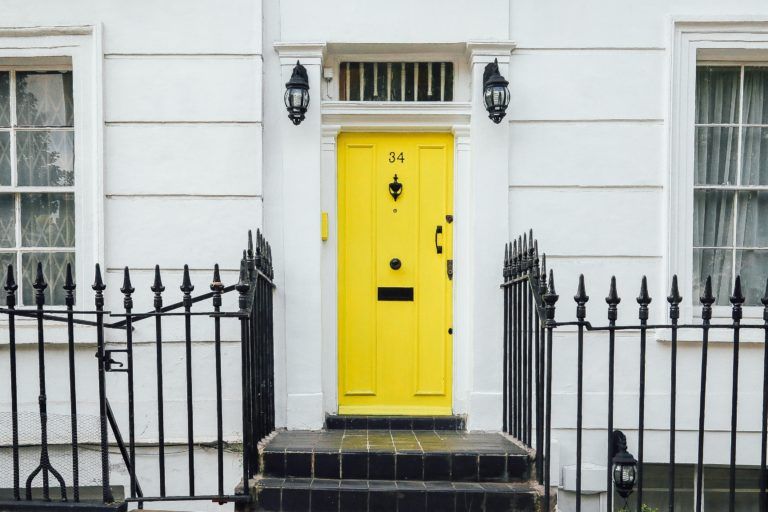
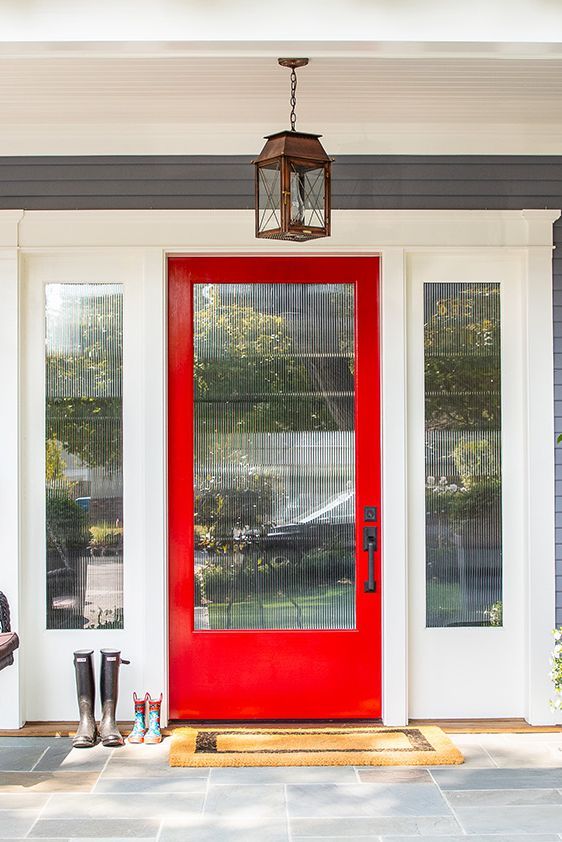
How to determine when you should replace your windows.
The windows in your home do more than give you a view of the outdoors. They form a barrier between you and the elements. Sometimes you can maintain this barrier with simple window maintenance and repairs. Other times replacement of one or more of your windows is the only option.
How do homeowners determine when they should replace their windows? You should always replace windows when they are not:
Energy Efficient
If you’re still using single pane windows, or you’ve experienced noticeable drafts or moisture near your windows, then your home isn’t as energy efficient as it should be and your windows are a part of the problem. Modern dual pane windows and triple pane windows are designed to provide the ultimate protection against the elements. In addition to protection against wind, temperature changes and moisture, they also provide UV protection.
Visibly Strong
If one or more of your windows has large cracks and missing pieces, extensive rotting or pests, you definitely need to go the replacement route before these issues result in costly wall or interior damage caused by moisture pooling and mold. You should also replace dual- or triple- pane windows that have mold on the seals or condensation in the form of fog or ice crystals between the panes, as these are indicators of seal failure. When seals fail, these types of windows are not only less energy efficient, but also extremely unhealthy because of mold growth.
Easy to Use
Your windows should never require a lot of work. Replace any window that sticks or freezes when opened or closed. If you have difficulty cleaning your windows, replace them with double hung windows that feature a tilt-in sash design. Also replace extremely high maintenance, painted windows that crack and peel with normal aging and require regular labor-intensive repainting. Another labor-intensive process is yearly storm window installation and removal. End the winter and summer window preparation cycle by replacing single pane windows with double- or triple- pane, all-season windows.
For more information about window replacement options, advice about your current home windows or answers to additional questions, contact our knowledgeable, experienced staff today!
Spring Cleaning Tips for Windows & Doors
Two of the crucial areas of your home to inspect thoroughly during spring are windows and doors. Well-kept windows and doors are vital for the home’s security, air conditioning, and even aesthetics. Winter can be tough on these structures, causing them to operate inefficiently or lose their aesthetic value. The experts at Quality Window & Door recommend the following spring home maintenance tips to ensure your home’s guard stays up!
- Inspect your windows and doors thoroughly
A lot can happen to your windows and doors during the past winter or summer seasons. An annual check-up is necessary during spring. Check for both minor and major problems so that you can know what needs fixing or replacement. Some of the common issues you may find with your structures include loose nuts and bolts, rotten wood, loose weatherstripping, chipped paint, squeaking hinges, clogged door tracks, and more.
- Clean your windows and doors
You can clean dirty window glass surfaces with water and a microfiber cloth. We recommend Norwex microfiber cleaning cloths. When cleaning your exterior doors, consider their stain or paint finish. It is advisable that you request advice from a professional on the best cleaning products to use on doors. Also, clean sliding door tracks and window casings to ensure the doors and windows close without making noises or jamming on the tracks. Also, clean sliding door tracks and window casings to ensure that the doors and windows close without making noises or jamming on the tracks.
- Repair or replace worn out hardware
Inspect all hardware parts of your windows and doors for tight-fitting or wear and tear. If bolts and nuts are loose, try to tighten them with a screwdriver. If they are worn out or damaged and need replacements, contact a professional to handle it for you. In addition, check all the moving parts on windows and doors to see if they are well lubricated. All gliding parts should be well lubricated at least once per year to reduce friction and prolong the life of hinges and bearings among others. Test the door and window locks to see if they are operating seamlessly. Your main exterior door should remain sturdy at all times for security reasons.
- Repair or replace the weatherstripping
The sealant or caulking on your windows or exterior doors is imperative in keeping these structures watertight and ensuring energy efficiency. Check the weatherstripping to see if it’s broken, loose, damaged or has gaps. If it’s destroyed and requires minor repairs, you can do buy a sealant and handle the repair on your own by following the manufacturer’s instructions or calling the experts at QWD for expert advice.
- Install window treatments and coverings
Consider installing window coverings such as blinds, shutters or draperies. They will not only help improve your home’s aesthetics but also boost your energy savings. They help reduce heat gain in the summer and heat loss in the winter.
Tuning up your home’s windows and doors this summer will go a long way in helping you identify and resolve issues early before they become expensive problems in the future. Contact the professionals at Quality Window & Door today for timely, affordable, and reliable inspections and repair for spring home care!
Takeaways:
The spring maintenance checklist for your windows and doors include:
- Inspecting windows and doors thoroughly
- Cleaning them and their components
- Lubricating, repairing or replacing their hardware
- Fixing or replacing weatherstripping
- Installing window blinds, shutters or drapes
8 Benefits of New Windows & Doors.
You’ll have a hard time finding a project that brings as many benefits and stretches your investment dollar farther – than new windows and doors. Here are some of the benefits you’ll start enjoying from day one:
- Increased home value.New windows and doors can return homeowners. 71 to 78 percent of the project cost upon resale.
- Enhanced safety and security. Windows that don’t open easily or are painted shut are more than just an annoyance – they can be a safety hazard, for example when trying to escape during a fire. Also, doors with multi-point locks are harder to break through than those with only one lock.
- Reduced dust and allergens.Blinds and shades tucked between the panes of glass stay protected from dust, helping to reduce allergens in your home.
- Improved comfort. Energy-efficient, well-sealed windows and doors can help reduce cold drafts and hot spots in your home.
- Improved energy efficiency.New windows or doors can reduce wear on your furnace and air conditioner, helping you save money by improving your home’s energy efficiency.
- More peace and quiet. Insulating frames and triple-pane glass help reduce the noise from traffic, lawn mowers and barking dogs.
- An enhanced view.New windows or doors can dramatically improve the beauty of your home – inside and out.
- Less time spent cleaning. Today’s windows and doors are designed with convenient features that make it easier to clean places that used to be harder to reach
Modern Cabin with Floor-to-Ceiling Windows Floats in the Trees
A compact but impactful cabin with a Pacific Northwest flavor takes full advantage of stunning lake and forest views.
Nestled in the woods of Northeastern Minnesota, Jewel Box Cabin takes full advantage of the spectacular view of Caribou Lake. And while modest in terms of square footage, this modern cabin boasts tall ceilings, exposed beams, floor-to-ceiling windows and doors, and a thoughtful balance between public and private spaces that creates an impression of volume and breadth.
Sara Imhoff, owner and founder of Imprint Architecture and Design, worked closely on this project with homeowners Daniel and Elizabeth and their daughter Emily. Uninterested in a traditional north woods log cabin and with a fondness for the design styles commonly found in the Pacific Northwest, Imhoff’s clients wanted to push boundaries.
After touring Imhoff’s newly designed home on the AIA MN Homes By Architects tour, the homeowners were already familiar with her Seattle architectural roots. Designs for their new cabin were forefront. “The homeowners were looking for a sense of being in a space that faces outward, into the natural forest and setting – that was their goal. Those concepts are often found in the Pacific Northwest design style.” Imhoff added.
The aesthetic feel was important, but so was utility. Imhoff’s clients wanted a simple and uncomplicated interior that utilized every inch of the 900 square feet. On the main floor, the powder room, mechanical room, storage space and laundry are separated from the great room by one huge sliding plywood door. This replaces the need for multiple doors, which saves space and maintains material sightlines and a sense of openness. The bedrooms are located on the second floor, which provides some privacy from the great room located below. With multi-purpose space in mind, Imhoff added a flex space that serves as an office or sitting area but can also accommodate guests.
The roof structure, built with exposed architectural grade fir wood beams, handles heavy Minnesota snow loads. Plywood runs on the lower ceiling from the front porch into the interior hallway and through to the back porch. “The plywood we used was pine,” Imhoff says. “It has a light feel compared to the traditional half-round log-sided cabin. The homeowners have two dogs, one Samoyed and one Newfoundland. Plywood is a durable material that won’t be damaged when two big, active dogs brush up against it. Plywood also provides a bit of texture and contrast from what would normally be standard drywall.”
A low maintenance exterior was a priority and was achieved with metal siding. “The only exterior cladding that requires regular maintenance is the cedar siding on the lower portion near the entry,” Imhoff explains. “The tight knot cedar was placed in that area strategically because it’s on the north side and covered from the elements, and it’s lower, so if it does need to be sanded or stained and refinished every six or so years, it’s much easier because it can be reached with a small ladder.”
The wall-to-wall, floor-to-ceiling windows maximize the lake and tree views and create a strong connection to the outdoor space and nature. Ample daylighting reduces the cabin’s electrical needs, and the large South-facing windows provide for passive solar heating in the winter.
When Imhoff designs a living space, she prefers to place windows on at least three sides to capture the best qualities of the light while considering sustainable lighting design. A combination of direct glaze and casement windows with a dark finish (Ebony to the exterior and Designer Black to the interior) helped bring the modern cabin aesthetic to life. “We chose to install Marvin Signature Ultimate windows because they are a streamlined product. The frame and mullion have a clean modern look to them with a thin profile allowing for maximum sightlines. Marvin products provide options for larger expanses of glass, which cost less than if we would have bought more mulled units.”
The clients were delighted with their new forest retreat, saying when they’re sitting at their table and look up, they just see trees, almost like living in their own cozy treehouse. They initially thought that they might visit once a month during the summer, but now find themselves there all the time. Imhoff was also pleased with the results. “I think that architecturally, the cabin was the client’s way to express their creativity outside of their normal everyday routine. They said that I had checked off everything on their wish list, which was really gratifying.”
Like most successful projects, Imhoff agrees that the Jewel Box Cabin was a collaborative effort. “Zane Kanyer with Swensen Say Faget Structural Engineering, did a great job. Max Construction expertly executed the drawings and design and the support with the window design and layout that Marvin’s architectural project team provided was indispensable.”
Photography by James Kruger, Landmark Photography. Courtesy of Sara Imhoff, Imprint Architecture and Design.
Windows with Built in Blinds—Worth It or Not?
For all their convenience, window blinds can be kind of a pain sometimes. Who hasn’t pulled too hard on one side of the cord, ending up with a lopsided effect? Or maybe you’ve wondered how to clean dusty blinds without taking it slat by slat? Or worse, worried that an adventurous child or pet might get themselves tangled in the cord?
Thankfully, windows manufacturers have finally gotten wise to all these problems and designed windows with built-in blinds. In these windows, the blinds sit positioned between two panes of glass, rather than as a separate treatment over the frame. You operate the blinds using a remote control, or via a magnetic slider that runs along the side.
Still, having the blinds inside the glass changes the look and behavior of your window treatments and, potentially, the energy efficiency of your whole window. While some people find them much more convenient, they’re not for everyone. Here are some of the pros and cons so you can decide for yourself if integral blind window replacement is right for your home.
Benefits of Windows with Blinds Inside
The pros of windows with blinds built inside the glass are usually cleaner, safer for your home, and less frustrating than regular blinds. Here are some of the top reasons people have integral blind windows installed in their home.
- Reduced maintenance: Manufacturers claim that having the blinds inside the glass virtually eliminates the need to dust or clean them (although in reality, some homeowners report that they have to clean them every couple of years). Well-sealed windows don’t accumulate dust and other allergens the way traditional window treatments do. That makes them a huge plus for many homeowners, since cleaning blinds thoroughly can be a tedious job.
- Less risk of breakage: Having the blinds behind the glass protects them from damage and routine wear and tear. Blinds frequently become brittle and break over time, particularly if you have less expensive vinyl treatments installed on your windows. But even higher quality products aren’t safe from pets or young children who may bend or break the slats. Because of this, most homeowners find themselves replacing the blinds frequently, probably once every four years or so. No so with integral blinds. Although internal blinds certainly aren’t invulnerable to damage, they may potentially last as long as the windows themselves. Many even come with a ten or twenty-year warranty.
- Safer for families with young children: The benefits of integral blinds extend beyond mere aesthetics, particularly if you have toddler-aged kids in the house. The cords on traditional blinds pose a risk of strangulation to young children—the watch group Parents for Window Blind Safety reports almost 600 cases of cord-related incidents in the past 30 years. Since they’re absolutely cordless, integral blinds skirt this risk altogether, offering parents huge peace of mind.
- Convenience: Blinds can be difficult to operate. But the magnetized slider simplifies the whole process. Or, if you go with a motorized version, you can avoid the hassle of manual operation altogether. And integral blinds make a great choice for large glass doors, since they won’t swing and get in the way of the door’s movement.
Cons of Built in Window Blinds
The cons of having built in window blinds would be that they are costly to install, are not always the most stylish options for replacement windows, and can decrease your window’s energy efficiency rating. Here are a few more downfalls of built in window blinds.
- Increased price: Purchasing a new window with built-in blinds obviously costs more than a set of blinds. And manufacturers typically classify windows with integral blinds as specialty products, meaning you’ll have to spend more than traditional models..
- Limited design options: Speaking of selection, that’s another limitation you may face if you choose to go with internal blinds. While traditional blinds come in almost any material you can think of, from bamboo to aluminum to pine, your choices may become much more limited if you decide to purchase internal blinds. Also, due to the slider, you won’t find them in a variety of styles, either, such as Venetian or roller blinds.
- Decreased energy efficiency: Manufacturers will usually insulate windows with argon, which they seal between double pane windows to slow drafts. However, they may forego this insulation in models that include integral blinds in order to maintain the integrity of the window treatments. And that can lower the window’s U-factor, the measure of its insulation. To avoid this issue, look for triple pane window models, ensuring that the window has a separate layer of insulated glass.
Overall, if you need new windows anyway and struggle with traditional window treatments, new window replacements might be a great solution. Integral blinds definitely make opening and closing the windows easier. And who couldn’t use a little less hassle in their life.


